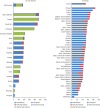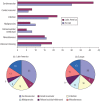The epidemiology of renal replacement therapy in two different parts of the world: the Latin American Dialysis and Transplant Registry versus the European Renal Association-European Dialysis and Transplant Association Registry
- PMID: 31093115
- PMCID: PMC6386019
- DOI: 10.26633/RPSP.2018.87
The epidemiology of renal replacement therapy in two different parts of the world: the Latin American Dialysis and Transplant Registry versus the European Renal Association-European Dialysis and Transplant Association Registry
Abstract
Objective: To compare the epidemiology of renal replacement therapy (RRT) for end-stage renal disease (ESRD) in Latin America and Europe, as well as to study differences in macroeconomic indicators, demographic and clinical patient characteristics, mortality rates, and causes of death between these two populations.
Methods: We used data from 20 Latin American and 49 European national and subnational renal registries that had provided data to the Latin American Dialysis and Renal Transplant Registry (RLADTR) and the European Renal Association-European Dialysis and Transplant Association (ERA-EDTA) Registry, respectively. The incidence and prevalence of RRT in 2013 were calculated per million population (pmp), overall and by subcategories of age, sex, primary renal disease, and treatment modality. The correlation between gross domestic product and the prevalence of RRT was analyzed using linear regression. Trends in the prevalence of RRT between 2004 and 2013 were assessed using Joinpoint regression analysis.
Results: In 2013, the overall incidence at day 91 after the onset of RRT was 181 pmp for Latin American countries and 130 pmp for European countries. The overall prevalence was 660 pmp for Latin America and 782 pmp for Europe. In the Latin American countries, the annual increase in the prevalence averaged 4.0% (95% confidence interval (CI): 2.5%-5.6%) from 2004 to 2013, while the European countries showed an average annual increase of 2.2% (95% CI: 2.0%-2.4%) for the same time period. The crude mortality rate was higher in Latin America than in Europe (112 versus 100 deaths per 1 000 patient-years), and cardiovascular disease was the main cause of death in both of those regions.
Conclusions: There are considerable differences between Latin America and Europe in the epidemiology of RRT for ESRD. Further research is needed to explore the reasons for these differences.
Objetivo: Comparar los datos epidemiológicos del tratamiento sustitutivo de la función renal (TSFR) para la nefropatía terminal en América Latina y Europa, así como estudiar las diferencias en cuanto a indicadores macroeconómicos, características demográficas y clínicas de los pacientes, tasas de mortalidad y causas de defunción entre estas dos poblaciones.
Métodos: Utilizamos los datos de 20 registros renales latinoamericanos y 49 europeos, a nivel nacional y subnacional, que le habían proporcionado datos al Registro Latinoamericano de Diálisis y Trasplante Renal (RLADTR) y al Registro de la Asociación Europea Renal–Asociación Europea de Diálisis y Trasplantes (ERA-EDTA, por su sigla en inglés), respectivamente. Se calculó la incidencia y la prevalencia del TSFR en el 2013 por millón de habitantes, en total y por subcategoría (edad, sexo, nefropatía primaria y modalidad de tratamiento). Se analizó la correlación entre el producto interno bruto y la prevalencia de TSFR mediante regresión lineal. Se evaluaron las tendencias en la prevalencia de TSFR entre el 2004 y el 2013 mediante un análisis de regresiones lineales segmentadas.
Resultados: En el 2013, la incidencia general al día 91 después de iniciar el tratamiento sustitutivo de la función renal era de 181 por millón de habitantes en los países latinoamericanos y de 130 en los países europeos. La prevalencia general era de 660 por millón de habitantes para América Latina y de 782 para Europa. En los países latinoamericanos, el aumento anual promedio de la prevalencia fue de 4,0% (intervalo de confianza de 95% [IC]: 2,5%-5,6%) entre el 2004 y el 2013, mientras que los países europeos registraron un aumento anual promedio de 2,2% (IC de 95%: 2,0%-2,4%) durante el mismo período. La tasa bruta de mortalidad fue mayor en América Latina que en Europa (112 defunciones por 1 000 años-paciente, en comparación con 100 defunciones), y las enfermedades cardiovasculares fueron la principal causa de muerte en ambas regiones.
Conclusiones: Hay considerables diferencias entre América Latina y Europa en cuanto a los datos epidemiológicos del tratamiento sustitutivo de la función renal para la nefropatía terminal. Es necesario hacer más investigaciones para explorar las razones de tales diferencias.
Objetivo: Comparar o perfil epidemiológico de pacientes com doença renal em estágio final (DREF) em terapia renal substitutiva (TRS) na América Latina e na Europa e examinar as diferenças nos indicadores macroeconômicos, características demográficas e clínicas, taxas de mortalidade e causas de morte entre as duas populações de pacientes.
Métodos: O estudo foi baseado em informação de 20 registros latino-americanos e 49 registros nacionais e subnacionais europeus que haviam fornecido dados ao Registro Latino-Americano de Diálise e Transplante Renal (RLADTR) e Registro da Associação Europeia de Nefrologia e Associação Europeia de Diálise e Transplante (ERA-EDTA), respectivamente. A incidência e a prevalência de TRS em 2013 foram calculadas por milhão de habitantes (pmh), geral e por subcategorias de idade, sexo, doença renal primária e modalidade de tratamento. A correlação entre o produto interno bruto (PIB) e a prevalência de TRS foi analisada com o uso de regressão linear. Tendências na prevalência de TRS entre 2004 e 2013 foram analisadas com o uso de regressão linear segmentada.
Resultados: Em 2013, a incidência geral ao dia 91 do início de TRS foi 181 pmh nos países latino-americanos e 130 pmh nos países europeus. Observou-se uma prevalência geral de TRS de 660 pmh na América Latina e 782 pmh na Europa. No período 2004–2013, o aumento médio anual da prevalência foi de 4,0% (intervalo de confiança de 95% [IC 95%] 2,5%–5,6%) nos países latino-americanos, enquanto que houve um aumento médio anual de 2,2% (IC 95% 2,0%–2,4%) nos países europeus. A taxa de mortalidade bruta foi maior na América Latina que na Europa (112 versus 100 óbitos por 1.000 pacientes-anos) e doença cardiovascular foi a principal causa de morte em ambas as regiões.
Conclusões: Existem diferenças consideráveis entre a América Latina e a Europa no perfil epidemiológico dos pacientes com DREF em TRS. Outras pesquisas devem ser realizadas para investigar mais a fundo estas diferenças.
Keywords: Europe; Kidney failure; Latin America; chronic; dialysis; kidney transplantation; mortality; renal replacement therapy.
Conflict of interest statement
Conflicts of interest. None declared.
Figures





References
-
- Caskey FJ, Jager KJ. A population approach to renal replacement therapy epidemiology: lessons from the EVEREST study. Nephrol Dial Transplant. 2014;29(8):1494–1499. - PubMed
-
- Liyanage T, Ninomiya T, Jha V, Neal B, Patrice HM, Okpechi I, et al. Worldwide access to treatment for end-stage kidney disease: a systematic review. Lancet. 2015;385:1975–1982. - PubMed
LinkOut - more resources
Full Text Sources
